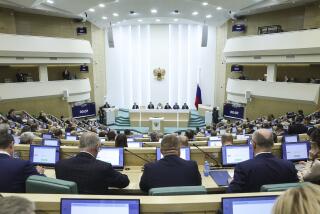U.S., Soviets Seem Near Accord on Verifying Limited A-Tests
- Share via
WASHINGTON — The United States and Soviet Union, in a significant sideshow to their strategic arms negotiations, seem close to agreeing to new verification measures that finally would lead to ratification of two treaties to limit nuclear underground testing to 150 kilotons, U.S. officials familiar with the talks say.
As chances have dimmed for the signing of a new strategic arms reduction agreement in May at the U.S.-Soviet summit in Moscow, nuclear testing is assuming a higher profile. Pressure is growing on both sides for speedy resolution of the issues so that President Reagan and Soviet leader Mikhail S. Gorbachev will have at least these arms control measures to initial.
The two testing agreements at issue, the Threshold Test Ban Treaty signed in 1974 and the Peaceful Nuclear Explosions Treaty of 1976, set an underground test limit of 150 kilotons (equal to 150,000 tons of TNT). The Threshold pact would deal with single shots and the Peaceful Explosions treaty would provide for a series of such blasts for larg1696621921canal.
Key Issues Remain
Two important issues remain to be resolved, however, if key verification measures involving the treaties are to be signed by Reagan and Gorbachev.
One concerns the timing of joint nuclear experiments at each other’s test sites and may be easier to overcome than the more substantial issue of whether and how often U.S. measuring instruments can be installed at a Soviet test site, and vice versa.
The two treaties have been observed by both sides since they were signed, although they were never ratified by the United States, in part because of the Soviet invasion of Afghanistan in 1979. The Reagan Administration, charging Soviet violations, demanded improved verification provisions before allowing the treaties to become law.
When the Soviets agreed to talks on new verification measures two years ago, the Administration promised that once the treaties were ratified, negotiations could begin toward a ceiling on the number of test explosions permitted each year--there is now no limit--and on reducing the ceiling of 150 kilotons on maximum yield.
Different Goals
The two nations differ fundamentally on their eventual goal on nuclear tests. The Soviets want a comprehensive ban on tests of all sizes, while the Administration believes that at least some testing must be conducted to ensure reliability of the U.S. weapons stockpile.
The Americans and Soviets also differ on whether on-site measurements are needed to verify that test explosions do not exceed the 150-kiloton limit.
The Soviets maintain that an explosion’s yield can be adequately measured with seismic instruments from distant locations. The United States believes that such readings can be in error by large margins depending on the geophysical nature of the test site.
In a move to resolve the disagreement, the two sides agreed to joint experiments at each test range--at Nevada and at Semipalatinsk, in Kazakhstan--using similar “hydrodynamic” measurement systems that reduce the error.
The U.S. system, called CORRTEX, consists basically of a coaxial cable that is lowered down the hole in which the explosion occurs or parallel to it nearby. The rate at which the explosive force crushes the cable, and thereby interrupts the electric current continuously flowing through it, is a measure of the test yield.
The Soviet system relies on switches along the cable that are destroyed as the explosive force moves along its length.
More to Read
Sign up for Essential California
The most important California stories and recommendations in your inbox every morning.
You may occasionally receive promotional content from the Los Angeles Times.










